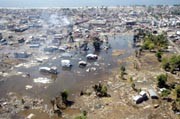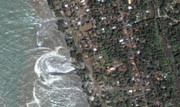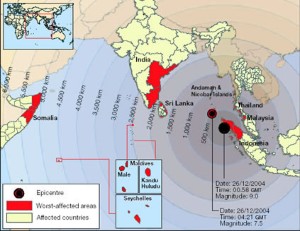AND IN AFTERMATH: LIES, APPEASEMENT AND COVER-UP
JERZY CHOJNOWSKI
CHAIRMAN-GTVRG e.V.
########
Inadequate warning system left Asia at the mercy of tsunami
Naturevolume 433, pages3–4 (2005) |
Scientists and governments were caught unprepared.
Washington

Devastated: the shattered remains of Meulaboh in Indonesia, largely destroyed by the tsunami. Credit: D. ALANGKARA/AP
When two tectonic plates beneath the Indian Ocean cracked past each other at 0:59 GMT on 26 December 2004, the sea floor was forced upwards by some 10 metres. This displaced in the region of a trillion tonnes of water, driving it towards southeast Asia's coastline in a long, low-amplitude wave travelling at up to 900 kilometres per hour.
When the wave reached shallower water near the coast, it shortened, slowed and gathered into surges that killed at least 150,000 people across a dozen countries. In the aftermath of the disaster, casualties continue to mount at a ferocious pace.
Seismologists knew about the magnitude 9 earthquake within minutes (see ‘Triple slip of tectonic plates caused seafloor surge’), but the absence of monitoring equipment in the ocean itself meant that they didn't know for sure that a tsunami had occurred. Those who suspected as much were unsure how to get the word out to the regions most at risk.
Although the small global community of tsunami researchers had expressed some concerns about the risk of such an event, little had been done to plan for it. “It is always on the agenda,” says Vasily Titov, a tsunami researcher at the Pacific Marine Environmental Laboratory in Seattle, Washington. But he says that it has been difficult to raise the money for a monitoring system. “Only two weeks ago it would have sounded crazy,” he says. “But it sounds very reasonable now. The millions of dollars needed would have saved thousands and thousands of lives.”
The most recent comparable event in the region took place in 1883 (see ‘Tsunamis: a long-term threat’). In contrast, earthquakes in Chile in 1960 and Alaska in 1964 led to the creation of a reasonably sophisticated tsunami warning system in the Pacific Ocean. Two international tsunami warning bodies exist under UNESCO's Intergovernmental Oceanographic Commission (IOC): the International Coordination Group for the Tsunami Warning System in the Pacific, known as ITSU, and the International Tsunami Information Center based in Hawaii. They get by on annual budgets from the IOC of about US$40,000 and $80,000, respectively, which are supplemented by grants from nations on the Pacific rim.
Displacement data
To predict a tsunami with any useful time advantage, researchers say, data on small changes in sea level and pressure have to be collected directly from the floor and surface of the ocean. The strength of the event depends on the displacement of the ocean floor, not on the strength of the earthquake.
Some buoys that could provide such data are already in place in the Indian Ocean. And only a few weeks before the tsunami struck, members of ITSU were talking about how these could be adapted for use in a tsunami-warning system, says Peter Pissierssens, head of ocean services at the IOC.
Within 20 minutes of the earthquake, at least three monitoring stations in the United States had detected it, initially estimating its magnitude to be around 8. The United States Geological Survey (USGS) circulated the information to about 100 people, mostly its own researchers and senior officials, within 16 minutes, and sent a more detailed bulletin to a list of external contacts, including the US Department of State, after an hour. The USGS has no responsibility for tsunami monitoring and its statement did not mention the risk of such an event.
The Hawaii-based Pacific Tsunami Warning Center (PTWC), meanwhile, sent out a bulletin to its regular circulation list, noting that the event presented no tsunami risk in the Pacific. According to Laura Kong, director of the International Tsunami Information Center, “let's keep an eye on it” was the prevalent attitude that night. “At that point, none of us expected anything like what we have seen,” says Charles McCreery, director of the PTWC and deputy chair of ITSU. “We expected a local tsunami at most.”
At 2:04 GMT, the PTWC put out another bulletin revising the quake up to magnitude 8.5. Because there was no information about sea levels in the area, the existence of a tsunami was merely hypothetical, but staff were worried enough to begin looking for numbers to call in Asia.
Communication breakdown
According to Kong, the team tried and failed to reach colleagues in Indonesia. Australia was contacted, although to little avail, as that country experienced only half-metre waves. It was not until 3:30 that the team in Hawaii saw news reports on the Internet of casualties in Sri Lanka. The wave had already crossed the ocean, to devastating effect.
Kong says that without a predetermined communication plan, warning efforts were doomed from the start. But she adds that the PTWC will in future directly contact the US state department, which can communicate risks to any nation, at any time.
Indonesian seismologists initially underestimated the strength of the earthquake, according to local news reports. And although officials there had very little time in which to act, an instrument that could have helped warn them of the approaching wave was transmitting its information to a dead phone line, according to a senior Indonesian seismologist (see news@nature.com doi:10.1038/news041229-4 ; 2004).
Efforts over the years to get an Indian Ocean warning system in place have made little progress in the face of national governments' reluctance to invest in them. In 2003, a working group on the Tsunami Warning System in the Southwest Pacific and Indian Ocean was established within ITSU. But Pissierssens says that the first chair of the group, a representative from Indonesia, left soon after his appointment and that the group then split into two according to region.
Phil Cummins a seismologist at Geoscience Australia in Canberra agreed to write a position paper for the group on tsunami risk in the Indian Ocean. “I am still in the process of writing that paper,” he says. “No one else was 100% convinced that we should worry and that included me, I've got to admit.”

Turning tide: the waters of the Indian Ocean tsunami recede after battering the coast of Sri Lanka. Credit: DIGITALGLOBE
According to Pissierssens, UNESCO will now make an observation system in the Indian Ocean a priority. “The first thing we will do is send out a survey team in January or February,” he says, “and then we want to set up a conference in the area.” Needless to say, there is little reluctance now to accept the need for the system. The UN International Strategy for Disaster Reduction has also said that one should be built within a year. And the Indian government, under intense domestic pressure for its failure to warn people on its eastern coast, said it would spend up to US$29 million to build a system itself (see ‘India pledges to fund alert system in wake of disaster’).
Nicole Rencoret, spokeswoman for the UN's disaster-reduction branch, notes that early warning systems could watch for other natural disaster risks, as well as tsunamis. “There has been an enormous amount of focus on tsunamis, but we need to take a multihazard approach,” she says.



Keine Kommentare:
Kommentar veröffentlichen